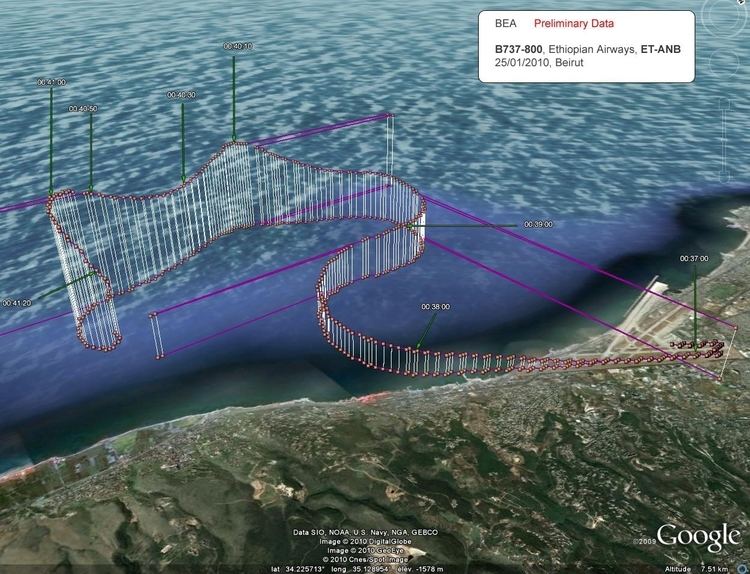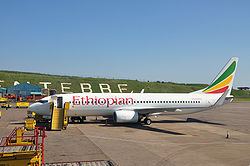Passengers 82 Date 25 January 2010 Total fatalities 90 (all) Passenger count 82 | Survivors 0 Registration ET-ANB Survivor 0 Crew count 8 | |
 | ||
Similar Partnair Flight 394, Santa Bárbara Airlines Fl, Ethiopian Airlines Flight 961, TANS Perú Flight 204, Air France Flight 296 | ||
Ethiopian airlines flight 409 beirut crash
Ethiopian Airlines Flight 409 was an international commercial flight scheduled from Beirut to Addis Ababa that crashed into the Mediterranean Sea shortly after takeoff from Rafic Hariri International Airport on 25 January 2010, killing all 90 people on board. This was the first crash for Ethiopian Airlines since the hijack of Ethiopian Airlines Flight 961 in 1996.
Contents
- Ethiopian airlines flight 409 beirut crash
- Aircraft
- Accident
- Search and recovery
- Investigation
- Passengers and crew
- Aftermath
- References

Aircraft
The aircraft involved was a Boeing 737-8AS, registration ET-ANB, s/n 29935. It had its maiden flight on 18 January 2002, and was delivered new to Ryanair on 4 February 2002 as EI-CSW. Stored in April 2009 (2009-04), Ethiopian Airlines took delivery of the aircraft on 12 September 2009, leased from CIT Aerospace. Provided with twin CFM56-7B26 powerplants, the airframe last underwent maintenance checks on 25 December 2009 without any technical problems found. It was 7008253065600000000♠8 years and 7 days old at the time the accident took place.
Accident

The Boeing 737 crashed into the Mediterranean Sea shortly after take-off from Beirut–Rafic Hariri International Airport in stormy weather, with 82 passengers and eight crew members on board. The METAR data indicated wind speeds of 8 knots (15 km/h; 9 mph) out of varying directions and thunderstorms in the vicinity of the airport. The aircraft climbed to 9,000 feet (2,700 m) before radar contact was lost about four to five minutes into the flight, while witnesses near the coast reported seeing the aircraft on fire as it crashed into the sea. The flight was scheduled to arrive at Addis Ababa at 07:50 local time (04:50 UTC).
Search and recovery

On the morning following the crash, Lebanese authorities reported having located the crash site 3.5 kilometres (1.9 nmi) off the coast from the village of Na'ameh. The search for survivors was carried out by the Lebanese Army, using Sikorsky S-61 helicopters, the Lebanese Navy and UNIFIL troops. The U.S. military, in response to a request from the Lebanese government, sent the guided missile destroyer USS Ramage, a Navy P-3 aircraft, and the salvage ship USNS Grapple. The French Navy sent a Breguet Atlantic reconnaissance aircraft. UNIFIL sent three ships (among them the German minesweeper tender Mosel and the Turkish B class corvette Bozcaada) and two helicopters to the scene. Further helicopters to assist search and possibly rescue measures were sent by the Royal Air Force, and the Cyprus Police aviation unit.

The recovered bodies were sent to the Rafik Hariri University Hospital in Beirut for DNA extraction and identification. On 5 February 2010, it was reported that the American vessel Odyssey Explorer was due to arrive during the next week to assist in the search for the aircraft cockpit voice recorder and flight data recorder. The Lebanese Army reported on 6 February that several large sections of the aircraft, believed to include the tail have been found in 45 metres (148 ft) of water at a location 1.1 nautical miles (2.0 km) off the coast of Na'ameh. On 7 February 2010 the Lebanese Army divers were able to recover the plane's flight data recorder; which was sent to the Beirut Naval Base to be handed over to the plane crash investigation team. All the deceased had been recovered from the sea and identified by 23 February 2010.
Investigation
The Lebanese Civil Aviation Authority opened an investigation into the accident, which would see co-operation from the U.S. National Transportation Safety Board (NTSB), the French Bureau d'Enquêtes et d'Analyses pour la Sécurité de l'Aviation Civile (BEA) and Boeing. Lebanese President Michel Suleiman stated that terrorism had been ruled out as a cause. Lebanese Information Minister Tarek Mitri contradicted accusations that the aircraft should not have taken off in such stormy weather, claiming that all operations at the airport had been carried out normally. Lebanese Minister of Public Works and Transport Ghazi Aridi and Lebanese Defense Minister Elias el-Murr reported that the pilot had failed to follow instructions from the control tower to correct his path and avoid the storm. Ethiopian Airlines sent a 14-member team of investigators to the scene of the crash; the United States also sent experts from the National Transportation Safety Board to help probe into the accident. The NTSB team is assisted by three technical advisors from the Federal Aviation Administration and Boeing. The flight data recorder and cockpit voice recorder were located on 4 February, reportedly at a sea depth of 100 metres (330 ft) and approximately 3 kilometres (1.6 nmi) from the shore of al-Na'ameh and was sent to the BEA to undergo data analysis. Four divers from the French Navy's Undersea intervention diving group have been sent to the crash location. The Cockpit Voice Recorder was recovered missing a memory storage unit. This was reported on 16 February as having been recovered and forwarded to the BEA.
Before the CVR was recovered, some aviation experts speculated that bad weather alone could not have brought down the plane and suggested that a technical fault may have caused an engine to catch fire.
The final report released by the Lebanese Civil Aviation Authority stated that the flight crew mismanaged the aircraft’s speed, altitude, heading and attitude. The crew’s flight control inputs were inconsistent and these resulted in the loss of control of the aircraft. The crew failed to abide by Crew Resource Management principles of mutual support and verbalizing deviations and this prevented any timely intervention and correction of the aircraft’s flight path and maneuvers. The airline challenged the statements as biased, firmly convinced that the aircraft experienced an onboard explosion, based on eyewitness evidence of "a fireball falling into the sea", a CCTV video, and the lack of investigative information about the passengers and baggage. According to Stratfor reports and emails shown on wikileaks, several senior Hizbullah members were meant to board the plane, and Hizbullah headquarters including Hassan Nasrallah were convinced the crash was the result of an act of sabotage by the Israeli Mossad.
Passengers and crew
Ethiopian Airlines issued the following list of the nationalities of the victims:
The wife of the French ambassador in Beirut, Marla Sanchez Pietton, was among the passengers.
Aftermath
A memorial ceremony was held in the Ethiopian Airlines premises in Addis Ababa on 14 February 2010.
